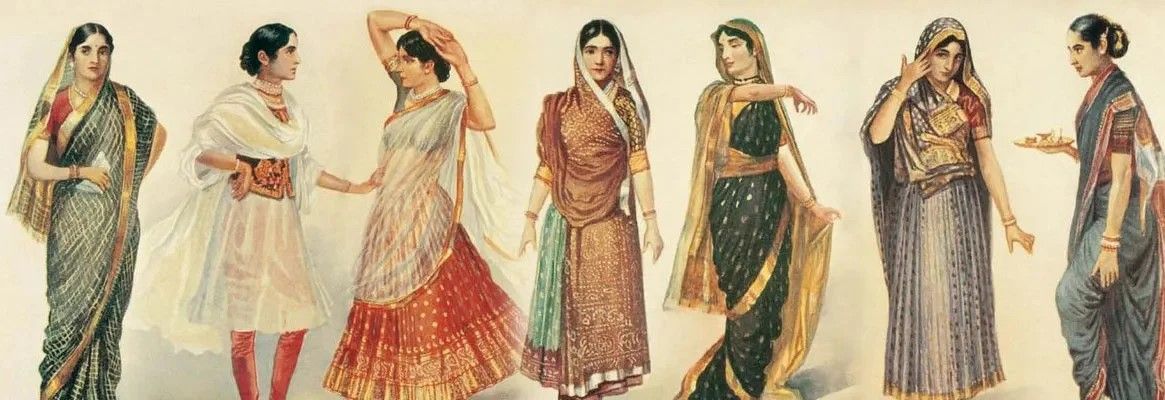
The costumes of ancient India offer a fascinating glimpse into the lives, beliefs, and societal structures of the people who inhabited the subcontinent over millennia. Unlike modern trends dictated by fleeting fashion, Ancient Indian attire was deeply rooted in tradition, climate, and practical considerations. Garments were primarily unstitched, relying on ingenious wrapping and draping techniques to create diverse and elegant styles. Literary Sources, including the Vedas, Brahmanas, Sutras, Epics, and Puranas, provide invaluable insights into the evolution of clothing materials, designs, and the symbolic significance of adornment throughout this period.
The Vedic Age: Simplicity and Functionality
The earliest textual references to clothing appear in the Vedic Literature, dating back to around 1500 BCE. The Rig Veda mentions basic garments like adhivastra (an outer veil), kurlra (a head-dress or ornament), and pratidhi (a part of a woman's dress). Linen and wool were the primary materials, reflecting the climate and available resources. Gold was highly valued, used extensively for crafting ornaments like niskaand rukma, which adorned the neck and ears.
The Atharva Veda provides a more detailed picture, describing garments as comprising an inner cover, an outer cover, and a chest-cover. Terms like nivi (underwear), upavasana (veil), vavri (upper garment), usnlsa, kumba, and tirlta(various head-dresses or ornaments) offer a sense of the developing complexity of attire. Footwear (updnaha) and blankets (kambala) were also mentioned, indicating an awareness of practical needs. While linen and wool remained dominant, silk began to appear, signifying a growing sophistication in weaving techniques and access to luxury materials. Cosmetics were used, and emphasis was placed on hair care, reflecting a nascent sense of personal grooming and aesthetics.
The Age of Brahmanas and Sutras: Refinement and Social Differentiation
The age of the Brahmanas saw an increased emphasis on dress and decoration. Knitting, sewing, and weaving techniques were well-established, enabling the creation of more elaborate garments. Wool, cotton, and silk were commonly used, with the basic dress consisting of a main portion, an outer garment, and an under-garment (nivi). Gold and silver ornaments remained popular, with necklaces made of gold or pearls gaining prominence.
The Sutra age witnessed further diversification in materials, with garments made from cotton, wool, flax, hemp, animal skin, silk, and bark. Ksauma (linen) and Kauseya(silk) were explicitly mentioned, denoting specialized fabrics. The practice of wearing an upper and lower garment became more standardized, with the usnisa (turban) used on specific occasions. Adhivdsa denoted an upper garment, while prdvaranareferred to a wrapper or outer cover. Weaving and sewing were common practices. Ornaments were worn by both men and women, including earrings, necklaces (niska), and ornaments like rukma. Flowers and garlands were widely used, particularly during marriage ceremonies. Mirrors, collyrium (kohl), and fragrant unguents were employed as aids to enhance beauty. Hair styling was also important, with different styles and rituals related to shaving the head and beard depending on religious or social circumstances.
The Epic Age: Grandeur and Regional Variations
The Ramayana and Mahabharata, the two great epics of India, provide vivid descriptions of costumes, showcasing the grandeur of the era. Glittering robes and elaborate ornaments were common, particularly among royalty and nobility. Men typically wore two pieces of unstitched cloth – a lower garment (vastra) and an upper garment (uttariya). Women also wore an uttariya and an adhovastra. The mention of sucl (needle) and tunnavdya (tailor) in the Ramayana suggests that stitched clothes were gaining acceptance, albeit perhaps for specific purposes or for certain social classes. Kancukas (jackets) and usnlsas(turbans) were often worn by attendants and soldiers. Wooden or leather sandals were commonly used.
Ornaments played a crucial role in signifying status and enhancing beauty. Kundala (ear-ornaments), hara (necklaces), hastabharana (bracelets), and ahgullyaka (rings) were widely worn. Necklaces came in various styles, including graiveyaka, maid hiranmayi, and niska. Bracelets like ahgada, keyura, pdrihdrya, and valayawere popular. Women likely wore girdles and Nupura (anklets with tinkling bells). Floral decorations were used by both men and women. Hairstyling was a significant aspect of personal presentation, with women often dividing their hair into two braids.
The Mahabharata highlights regional variations in clothing, with festive attire of the Ceylonese studded with jewels and the Kiratas of hilly regions wearing animal skin. The epic also confirms the widespread use of gold ornaments, even among men. Ear-rings were surprisingly common among males. Women's attire included silk cloth (often red) for brides, necklaces, earrings, jewels, niska, conch-made items, and bracelets.
The Age of Puranas: Consolidation and Continued Refinement
The Puranic age saw a consolidation of established trends in costume and adornment. Cotton, silk, wool, and linen remained the primary materials. Prdvarana(outer garments) were commonly mentioned. Hair was often shaved or styled, with long, dishevelled hair generally considered undesirable. Unkempt beards were also likely frowned upon. Head-dresses like usnisa and mukuta were common. Ornaments included keyura, ahgada, and waistbands. Perfumes and collyrium continued to be used.
Buddhism and Simplicity
Pali works provide insights into the garments of Buddhists, emphasizing simplicity and functionality. The Dhammapada refers to people clothed in yellow robes, symbolizing renunciation and detachment from worldly possessions.
In conclusion, the costumes of Ancient India were a reflection of the diverse cultural, social, and economic landscape of the subcontinent. From the simple yet functional garments of the Vedic age to the elaborate and ornamented attire of the epic and Puranic periods, clothing served not only as a practical necessity but also as a powerful means of expressing identity, status, and religious affiliation. The legacy of these ancient traditions continues to influence Indian fashion and culture to this day.